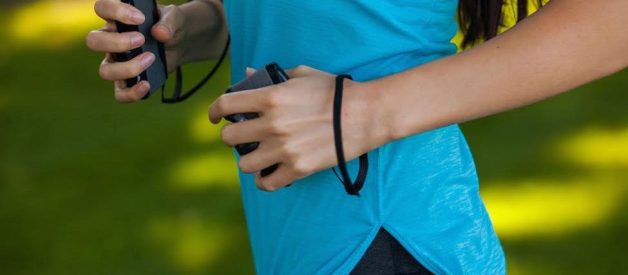
On a chilly night in 2010 I sat alone at a bus stop in Vancouver, shivering while I waited for my ride home. A young woman ? she couldn?t have been more than sixteen ? took a seat down the bench from me and asked when the bus was coming.
?It?s two minutes away,? I told her. She thanked me and stuffed her chapped hands into her pockets.
I never would have predicted what happened next.
After glancing up and down the street, she whistled to her friends nearby. Then she shuffled closer to me and told me, in a low voice, that I was going to hand her my bag ? and if I screamed, she?d kill me.
When I first learned about the TigerLady, a new self-defense tool for women that produces cat-like claws when squeezed, I thought about that night at the bus stop. If I?d had such a tool, would I have used it on the three teenagers who mugged me? Or would I have quietly turned over my bag as I did before?
The truth is, my ?flight? instincts are strong. I may act tough, but ?fight? is just not a response I have when I sense danger, and no amount of childhood martial arts classes could change that.
That?s why the TigerLady, released in 2015 and marketed heavily this year in response to widely covered sexual assaults ? such as the Brock Turner case ? piqued my interest. It?s a higher-tech version of carrying your keys between your knuckles (if you don?t know what I mean, check out this portrait project by student photographer Taylor Yocom, documenting the ways women guard themselves when walking alone). The TigerLady also has hollow grooves beneath its retractable claws that collect DNA from an attacker, useful when investigating and prosecuting crimes. Of all the self-defense devices I researched, from the Go Guarded ring to purse-sized pepper spray, the TigerLady seemed to have the best chance of not only protecting me, but also potentially contributing to the removal of an assailant from the streets.
***
The original TigerLady was patented by Al Levine in 1978. He was an inventor, inspired by ?birds of prey and big cats who have retractable claws and talons for hunting and self-protection,? according to his grandson, Josh Levine. Back then plans for the device didn?t get off the ground, but the younger Levine and his father, Jeff, picked up where Al left off and redesigned the device with modern women in mind.
?My family decided to bring this product to life due to the growing instances of sexual, domestic, and other types of assaults on women in the U.S. and around the world,? Josh Levine said. ?We hope to battle the sense of male entitlement that leads to catcalling, inappropriate grabbing and touching, and rape.?

The product, which costs about $30 to purchase and is manufactured entirely in the U.S. by a company that employs disabled veterans, is made from plastic and foam, so the company says it?s legal in all 50 states ? unlike brass knuckles, which are illegal in many parts of the country. It?s also non-lethal, so if an attacker were to grab it and turn it on its owner, the TigerLady might harm but would not kill her. Overall, it seems feasible that if you have the TigerLady in your hand, feel comfortable using it, and get attacked by a stranger on a darkened street, you might be prepared to fight your way out of the situation.
But as law enforcement expert and research director at End Violence Against Women International Kimberly Lonsway pointed out, the vast majority of assaults ? especially sexual ones ? are committed by someone known to the victim, in a familiar environment. According to the Rape, Abuse and Incest National Network (RAINN), three-quarters of rapes are committed by an acquaintance of the victim. Research from the Department of Justice shows that more than two-thirds of all violent crimes committed against women are perpetrated by someone they know. This means that most women probably won?t be carrying the TigerLady when they are attacked.
There?s another potential complication: What happens if you?re carrying the TigerLady and you?re attacked by a stranger on the street ? like I was ? and your fight-back response shuts down? Lonsway noted that women may beat themselves up for failing to use the TigerLady when they had the chance, which could add to their trauma. ?We see this [issue] with people who have self-defense training or people in the military or law enforcement,? she said. ?When they?re personally sexually assaulted [they?re] hard on themselves for not using their training.?
Yet Lonsway has carried her keys between her knuckles, so she sees how a product like the TigerLady could be useful. And, she adds, research shows that fighting back in the event of a sexual assault actually decreases the chance that the assault will be completed.
***
While it?s only been on the market a year, the TigerLady has a growing following among female runners. Women?s Running says women who carry it will feel ?extra safe,? and USA Today editor Natalie DiBlasio recommended runners carry it if they have experienced harassment.
?Until it looks like the sugartit-callers and the you-were-asking-for-it brainiacs are finished whatever it is they are doing,? she wrote in an article for Run Haven, ?I am going to be on the lookout for anything I can find to help women feel and be safer.?
While Josh Levine doesn?t know any women who have yet had to use the product (?we hope they never need to use TigerLady?), its unique DNA collection technology could be useful for law enforcement if a victim does use the device on an attacker. If an attacker has been previously convicted or, in some states, arrested before, it could help make a positive identification by comparing the DNA on the device to DNA stored in law enforcement databases. If the assailant?s DNA isn?t on record, it could match with unidentified DNA in another case and help bring investigators closer to finding the perpetrator. It could also be useful in court if the perpetrator is in custody, but claims he didn?t commit the assault.
?[In the case of a sexual assault] he?s going to claim consent and say she wanted it,? said Lonsway. ?The prosecution can say, ?No, here are the facts that prove this was forceful.? So it would be corroborative of force at that point.?
***
Whether a woman decides to carry the TigerLady or not, it?s worth explaining why three generations of men have dedicated themselves to arming women. According to Levine, it comes down to believing that women deserve to feel safe ? in every circumstance. ?I do personally consider myself a feminist,? he said. ?We are providing a product that is designed to capture DNA and leaves a physical mark behind in the hope that we can make a dent in the vast problems surrounding rape kits that go untested for months, and in some cases, years.?
One of the company?s goals is to donate a portion of its profits each year to an anti-violence group chosen by fans of the product; its first donation went to RAINN earlier this year. Levine told me he?d also like to get the product into the hands of more lower-income women, and is open to suggestions on how to do so. (The cost of the TigerLady is comparable to other self-defense devices being marketed to women but is still out of reach for women with lower incomes, who make up a disproportionate number of victims of violence.)
As for me, I?m not sure if I would have used the TigerLady back in 2010, even if I?d had it. Over the last week I?ve kept the device in my purse at all times, holding it in my hand while walking my dog at night or to and from my car after dark. It?s easy enough to use ? squeeze it and the sharp claws appear ? though it feels a little big in my hand; friends have agreed with me about the size when I?ve shown them my TigerLady.
While I?m generally pretty aware of my surroundings when I?m alone at night, I?ve definitely felt a heightened sense of myself and the people around me, and a different kind of confidence than I?ve ever had before. But as my ?flight? ? or rather, ?freeze up? ? instincts have always been strong, and are even more intense than they were before I was mugged (which lines up with research on the effects of trauma), I wonder if I?d kick into self-defense mode if I faced an attack now. Still, Lonsway says that women who are victimized more than once sometimes experience healing when they fight back the second time, and I?ll be keeping the TigerLady handy in case I?m ever in another scary situation.
***
Images from the TigerLady website. Used with permission.


